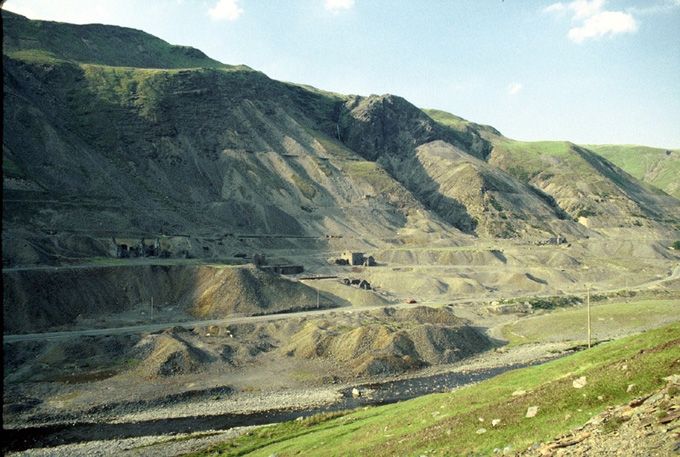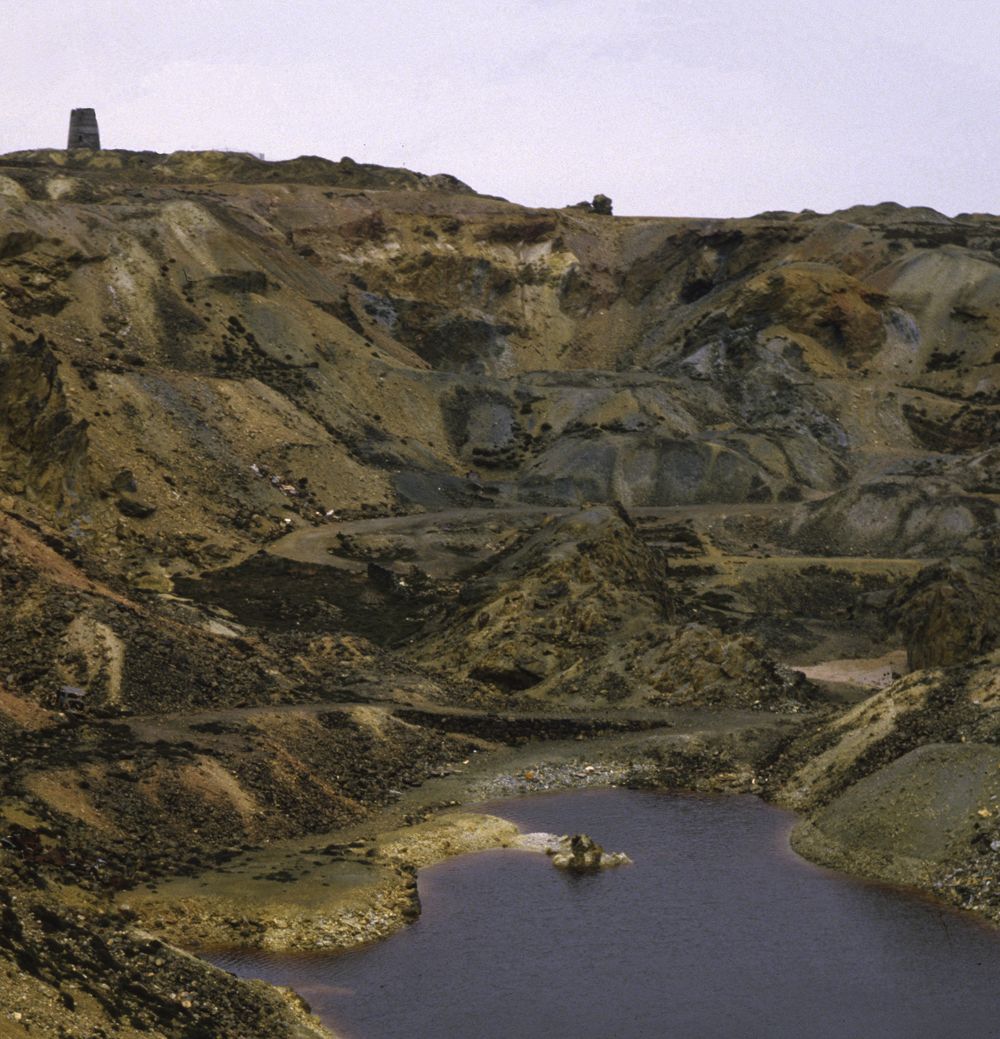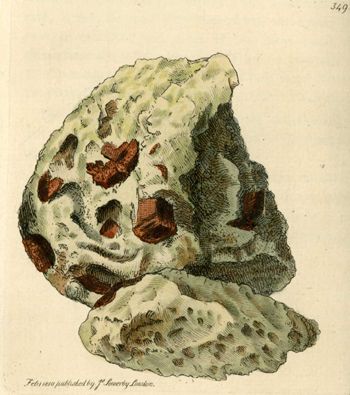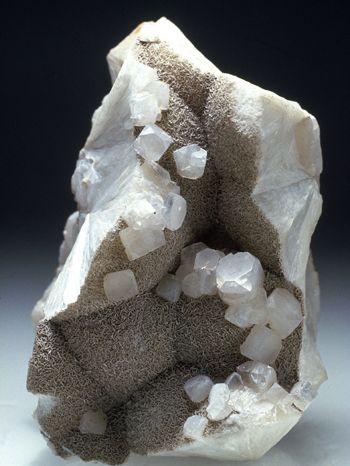History of Mineralogy in Wales
The First Mineral Prospectors in Wales
From archaeological investigations of several Welsh mines, we know that prospecting and mining for copper ores was an active pursuit in the middle Bronze Age, almost 1,500 years before the Roman occupation. The ability to: a) recognize minerals; b) distinguish useful ones from the rest; and c) make basic interpretations of mineral deposits would have been as much of a key requirement of the successful prospector (or mineralogist) then as it is today.
In the 3,500 years that have passed since those ancient times, minerals have played a major role in the economic and social development of Wales. Metalliferous and, later on, “spar” minerals have variously been worked by the Romans, by the Cistercian Monks, by celebrated seventeenth century mining characters such as Thomas Bushell and others, on into the heyday of Welsh metal mining in the mid nineteenth century, when virtually every outcropping vein or fault was tried by the drivage of adits or the sinking of shallow shafts. Gold, lead, silver, copper, iron, zinc and manganese have all been the focus of attention, while various successful attempts have been made to exploit cobalt, arsenic, antimony, barytes and calcite. We do not know the total production of each individual mineral – mainly because, until the late 1840s, few detailed records were kept of ores raised to surface, dressed into concentrates (the process by which sulphide-bearing rock is freed of waste material such as vein-quartz) and sold. The published totals for mineral production in Wales therefore represent an unknown percentage of the total.

Mining activity around Cwmystwyth, Mid-Wales is predominantly from the nineteenth century; however C14 dates give evidence of Early to Middle Bronze Age workings on Copa Hill (extreme right of photograph). © J.S. Mason.
Some of the mines were of European significance in their magnitude, such as Parys Mountain, Anglesey (copper - eighteenth Century) and Van, near Llanidloes in Powys (lead and zinc – nineteenth Century). Whole communities grew in such prosperous locations. This can be difficult to imagine, for example in mid-winter at (among many such places) Dylife, in north Powys. Other sites were no more than speculative trials, aimed at raising venture capital on the stock market and little more. The relative remoteness of some parts of Wales during the nineteenth centaury made it particularly vulnerable to unscrupulous ventures in which apparently fabulous reserves of ores seemingly evaporated away once the development capital had been secured. Meanwhile, a large number of mines fell in between the two extremes. The history of mining in Wales is a fascinating and complex subject and is, especially in terms of the past 250 years, mostly well documented.

A view looking north over the opencast pit at Parys Mountain, Anglesey. The picture was taken prior to remedial work at the site which necessitated the draining of the water at the base of the pit. Parys Mountain was the site of extensive copper extraction between 1750 and 1850. © J.M. Horák.
Key References:
Bick, D.E, 1993. The Old Metal Mines of Wales, Parts 1-6. Pound House, Newent.
Bick, D.E. 1985: The Old Copper Mines of Snowdonia. Second Edition, Pound House, Newent.
Davies, P.B.S. 1995. Forgotten Mines (The old lead and copper mines of Solva and St Davids (Merrivale, St Davids).
Hall, G.W. 1993. Metal Mines of Southern Wales. 2nd Ed. Griffin Publications, Herefordshire.
Hall, G.W. 1990. The Gold Mines of Merioneth. 2nd ed. 99pp. Griffin Publications, Kington.
Hall, G.W. 1995. The Minera Mines from 1849. In: Bennett, J. (Ed): Minera Lead Mines & Quarries. Wrexham Maelor Borough Council, p45-67.
Hughes, S.J.S. 1981. The Cwmystwyth Mines. British Mining No. 17. Northern Mines Research Society.
Hughes, S.J.S. 1988. The Goginan Mines. British Mining No. 35. Northern Mine Research Society.
Hughes, S.J.S. 1990. The Darren Mines. British Mining No. 40. Northern Mine Research Society, 131-141.
Mineral Collecting in Wales
Mineralogy, in the context of collecting minerals for their own sake, is an activity with a relatively short history in Wales. This is in stark contrast to the many centuries during which minerals were sought after as metal ores. It fell to the gentleman naturalists who flourished in the eighteenth and nineteenth centuries to begin assembling together the jigsaw that, although still incomplete, constitutes the Mineralogy of Wales. This is incomplete, because almost every year, records of species new to Wales are made and published.

Reproduction of the water colour plate of sulphate of zinc (goslarite) found at Holywell in Flintshire included within Sowerby's British Mineralogy (1811).
Occasional notes on individual mineral occurrences in Wales can be found in the early literature (e.g. Lhuyd, 1684 – as noted in Greenly (1919); Sowerby, 1811). However in in 1858, Robert Philips Greg and William Garrow Lettsom, following on from Sowerby’s British Mineralogy (1804-1817) published their famous Manual of the Mineralogy of Great Britain and Ireland.. This book represented the first attempt to list comprehensively and describe all of the minerals known to occur in the British Isles. A total of 241 mineral species was listed, of which 47 were noted from Welsh localities. Most of the species mentioned from Wales were, perhaps not surprisingly, minerals encountered during mining and quarrying - hence the common ores and alteration products of copper, lead and zinc feature in the list, as does gold. Their work was not exhaustive. For example, a description of analcime from Anglesey, published by J.S. Henslow (incidentally Charles Darwin’s tutor) in 1822, was omitted.
In contrast to other mining districts, such as those of Devon and Cornwall, the orefields of Wales were not greatly frequented by mineral dealers and specimen hunters. However, there were some exceptions including the noted eighteenth century naturalist Thomas Pennant (1726-1792) who was particularly active in his local area (the Halkyn district of north-east Wales). The famous mineral collection of his Cornish contemporary, Philip Rashleigh, contains specimens from this area: interestingly a Mr Pennant was one of Rashleigh’s specimen suppliers.

A fine specimen of pectolite from Hendre Quarry, near Glyn Ceiriog, Clwyd, coated with cubic apophyllite crystals. This specimen forms part of the G.J. Williams Collection, acquired by Amgueddfa Cymru - National Museum Wales in 1927.
Welsh mineralogy had a useful boost in the early twentieth century when much important material was collected by the then Chief Inspector of Mines for North Wales, G.J. Williams. His was a job of which many modern mineral enthusiasts would dream. During his tours of duty around the then working mines throughout North Wales, the opportunities to obtain fine contemporary specimens would have been legion. In 1927, the National Museum of Wales obtained Williams’ material.
Despite the gradual decline in the Welsh mining industry, interest in Wales’ minerals grew steadily throughout the twentieth century, with the 1960s onwards seeing a massive expansion in the numbers of active amateur collectors. Access to microscopes has enabled the study of microcrystalline (but often stunningly beautiful under magnification) minerals resulting in the discovery of many rare mineral species in Wales by the dedication of several amateur mineralogists.
This was reflected by the fact that, when the first edition of A Mineralogy of Wales was published in 1994, a total of 340 mineral species were included. Thus, in the 136 years since Greg and Lettsom’s work, the number of species known to occur in Wales had increased more than sevenfold. But, perhaps the most dramatic statistic of all is that 161 (i.e. almost half) of the 340 mineral species listed in the first edition were discovered in the period 1960-1994, through the work of academics and amateurs alike.
References:
Bevins, R.E., 1994. A Mineralogy of Wales. National Museums and Galleries of Wales, Geological Series No. 16.
Greenly, E., 1919. The Geology of Anglesey. Memoirs of the Geological Survey of Great Britain, 980pp (2 volumes).
Greg, R.P. & Lettsom, W.G., 1858. Manual of the Mineralogy of Great Britain and Ireland. John van Voorst, London, 483pp.
Sowerby, J., 1804. British Mineralogy. Volume I, Richard Taylor, London.
Sowerby, J., 1806. British Mineralogy. Volume II, Richard Taylor, London.
Sowerby, J., 1809. British Mineralogy. Volume III, Richard Taylor, London.
Sowerby, J., 1811. British Mineralogy. Volume IV, Richard Taylor, London.
Sowerby, J., 1817. British Mineralogy. Volume V, Richard Taylor, London.
